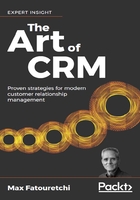
What to take away from the five case studies
As we can see in these five case studies, one of the most common elements of all CRM projects is building a comprehensive 360-degree client view that will be a supporting pillar for sales, marketing, and services processes automation. It is also important to support the company in building long-lasting relationships with clients, while managing the business and resources more efficiently based on insightful decisions, at a reduced cost of operation.
A comparison of these five case studies also reveals that every organization must implement its own unique sales process based on its vertical, products, industry, culture, and market position. What works for one company will often totally flop for another. As a case in point, I remember implementing a CRM solution for a company in Hungary that had the mother company in Norway. It was the same company, the same product, and the same industry, but each location had different sales processes that had to be optimized to the local company's culture and market position.
When you start the daunting task of designing the architecture of your CRM solution, you will find that you have some architectural questions that need to be answered in order to build a solid foundation:
- What information will be managed, stored, and presented?
- What are the main functional entities of your architecture?
- How will these entities interact with each other and with the outside world?
- What are the top processes to be supported by a CRM?
- Will a development, test, support, and training environment be needed?
Then there are a few concepts that you need to think about when you're finding a balance of these viewpoints:
- Static structures: Also known as cross-cutting concerns, these will impact all of the other architectural viewpoints.
- Dynamic structures: This is where you apply perspectives to your viewpoints in order to build a dynamic structure to better satisfy stakeholders who have different ideas about the key requirements.
- Quality properties: These look at performance, security, and availability.
Stakeholders, architectural description, viewpoints, and perspectives will be in your Solution Blueprint (SBP), along with a process catalog, use cases, and integration points, all of which we will cover in later chapters.
There are many dependencies to be considered; for example, the main users claim to need totally different information from what the staff members at the head office need. This is really connected information that supports a multistep process, which is often built on top of the same data from the central repository of customer data.
The business managers say it's crucial to have real-time summary reporting throughout the day, which may slow the transaction flow significantly, which is not acceptable to the main users of the system. Meanwhile, IT members are worried about adopting new technology, security, and compatibility issues. As you can see in the figure that follows, there are a number of different stakeholders involved in any CRM system.
The design of a sustainable CRM architecture will have to consider many dependencies, such as stakeholders, data centers, functional requirements, business processes, the feedback loop, and review management. In Figure 1.18, you can see these dependencies mapped out:

Figure 1.18: The dependencies illustrated
The case studies we've looked at in this chapter also demonstrate the need for an architect to identify and connect with all the key stakeholders. They need to understand stakeholders' objectives, perspectives, and conflicting priorities, and design an architecture that satisfies all the business requirements effectively within a reasonable TCO/ROI.
On top of a great CRM architecture design, there are a few important success factors that I will introduce here and discuss in more detail throughout this book:
- Management and employees must get involved and work together towards the success of a project.
- CRM is primarily a management and business issue, not an IT issue.
- CRM will support all channels, business units, and users.
- Business processes will define CRM processes and not the other way around.
- CRM will enable the measurement of success, customer profitability, share of wallet, and business process automation.
- Change management is crucial for success.